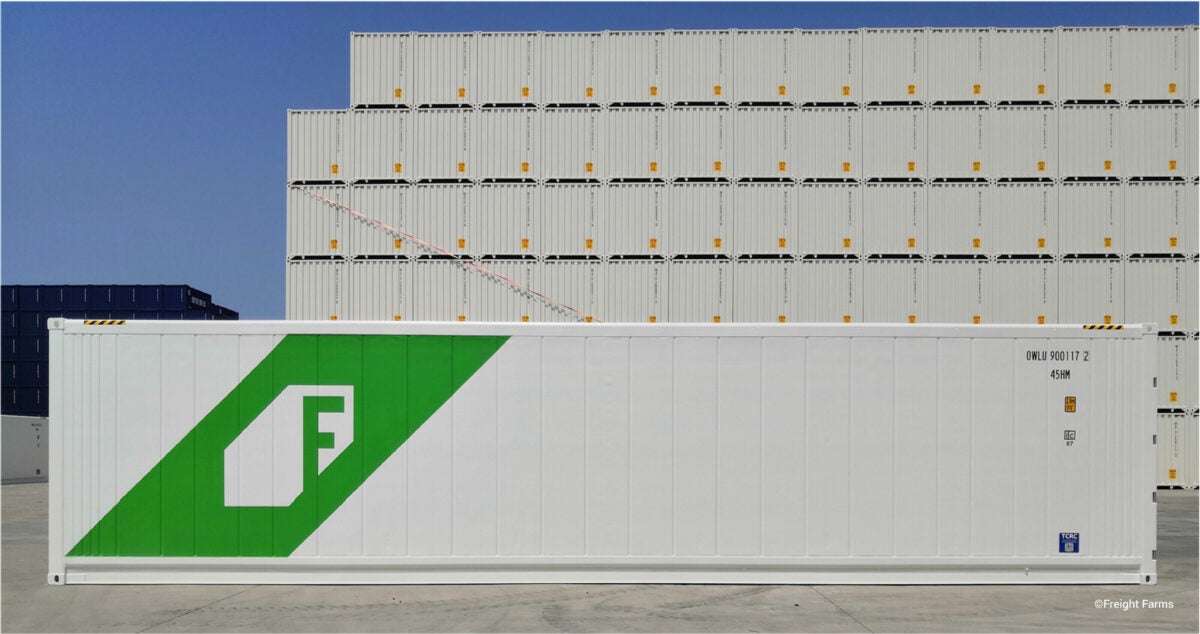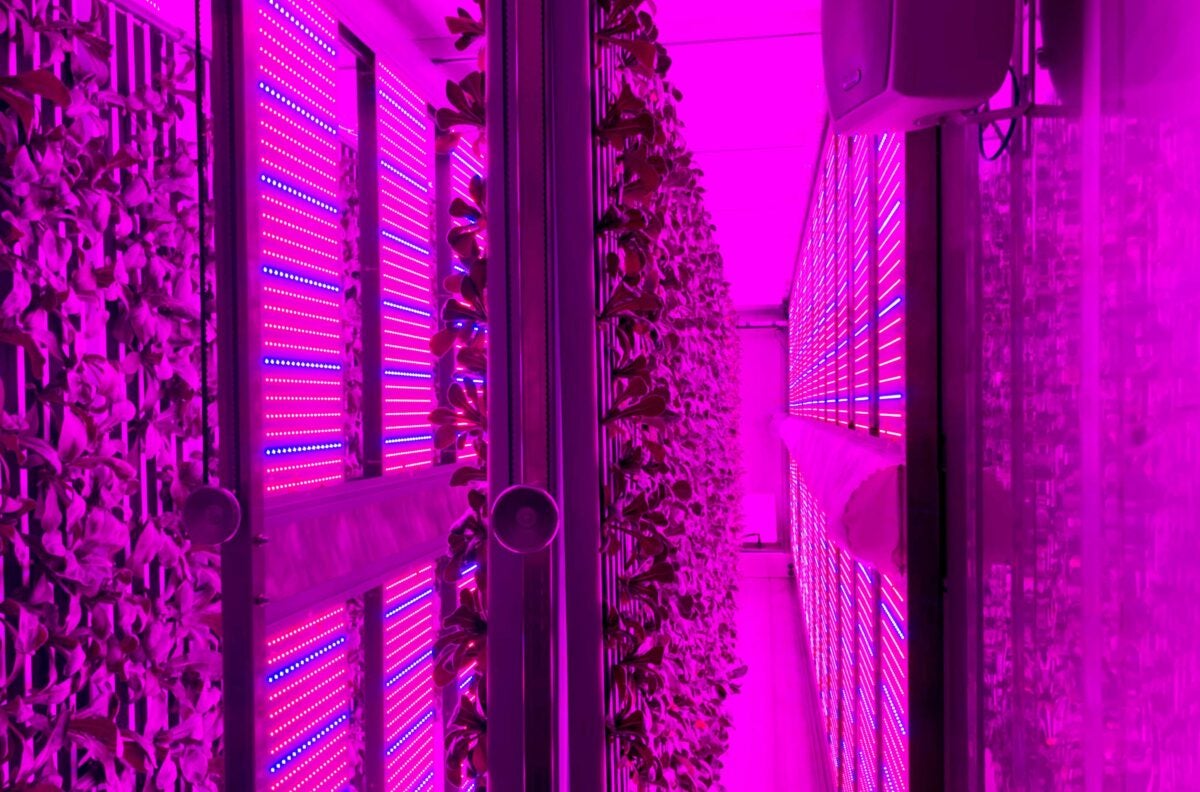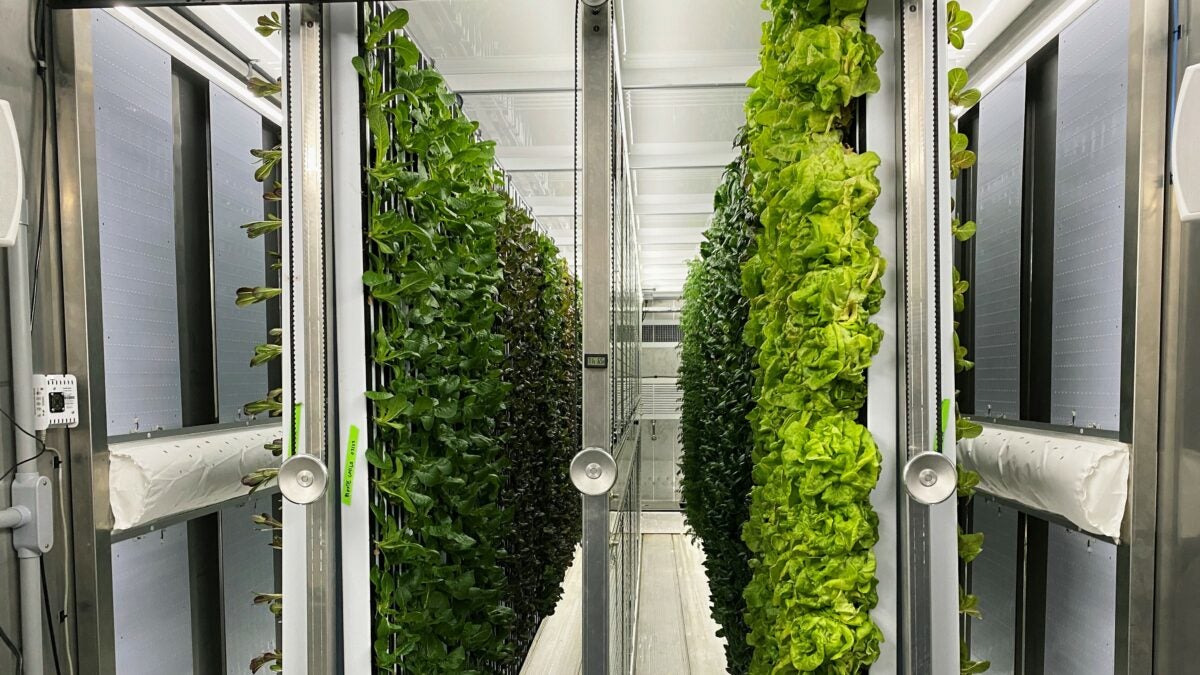Shipping containers haul food, sure. But increasingly, they grow it, too.
Just 5 gallons of water per day and the right amount of LED lighting, carbon dioxide, nutrients and humidity can yield bountiful harvests in shipping container farms — no pesticides or herbicides needed.
But could growing sustainable, pesticide-free food in a dimly lighted shipping container actually be profitable? The early signs are promising.
What started out as an idea to use controlled environment technology to grow fresh produce in small spaces has grown to a community of more than 400 Freight Farms containers around the world. Freight Farms uses hydroponics and the vertical space available in the 40-foot shipping containers to grow food.
“Whatever’s environmental always becomes economic. … I think food, or at least supply chain, is going to be the way that people see that the most,” Jon Friedman, co-founder and COO at Boston-based Freight Farms, told FreightWaves.
Friedman said the company has about 16 containers shipping out to their final destinations in the next few months, and it expects to have close to 500 farms in the network by the end of 2021.
Demand has grown to the point that the company can no longer wait for old shipping containers — formerly used in trucking or rail — to become available. New shipping containers are now being built with farming as their primary purpose. Meanwhile, repeat customers — such as Corner Greens, a Freight Farm in Peachtree Corners, Georgia — provide proof of sustained interest. Corner Greens added Freight Farms’ latest generation of container, the Greenery S, as its third farm just a few weeks ago.
How does the system work?
Farmhand is a software system that, said Freidman, “does the thinking for the farmer.” Farmhand and Greenery S were designed to work together and communicate information from sensors throughout the growing area and in the water and nutrient tanks. They implement the lighting, humidity, nutrient, water and temperature schedules that each operator chooses when setting up the system.
Friedman said he and co-founder Brad McNamara wanted to “make it so anybody can grow food 24/7, 365 days a year” cost effectively in their local communities. Many Freight Farmers have little to no farming experience, but they get the training, technical support and resources they need to shorten the learning curve.
Shipping container modifications
Friedman and McNamara started by experimenting with rooftop gardens in 2010 but soon realized that approach’s scale, cost and location limitations. The pair received requests from around the world following a 2012 R&D Kickstarter campaign for hydroponic, climate-controlled vertical farms in shipping containers. The insulation and structure, along with the fact that most areas have access to them, made shipping containers the perfect choice.
Friedman said the company started by refurbishing old shipping containers after founding the company in 2013, but the supply of suitable used containers dwindled quickly and was not consistent or centrally located. He said there was also a risk that containers the company received would be structurally unsound. The company refurbished its last used shipping container for a farm in 2019.
Now, Freight Farms sources custom-built containers equipped with climate control, insulation, more accessible doors, air flow modifications, and electrical and plumbing systems. But getting access to containers and shipping them overseas isn’t easy during a container shortage.

“We make up 10% of the custom container market and a small part of the overall container market (approximately 0.0001%). Multiple stressors on the system — labor and supply shortages — have affected our ability to build the containers overseas,” Friedman said.
“Additionally, space on ships is incredibly limited and competitive as thousands of companies fight to transport their goods via containers on ships, making it difficult to bring the finished containers to the U.S.,” he added. “We are being creative and protecting our supply chain by bringing containers in whatever way we can. … One strategy has been opening new shipping routes on the West Coast and using rails to transport the containers cross-country.”
Another strategy, Friedman said, is “pairing compatible imports and exports.” Using shipping companies that import goods to China can make it easier to find space for Freight Farms’ shipping containers on the route back to the U.S., he said. The company also fills its containers with third-party goods from retailers such as Costco when the containers are transported across the ocean to save space on container ships.
Once the containers reach Vermont, two New England-based companies modify them and install the necessary hardware so they are farm-ready. This includes drilling holes in the shell, making airflow modifications in the floor and installing the electrical, plumbing, HVAC and air flow systems. From there, these hydroponic farms can be shipped like a regular container to their final destinations — such as Corner Greens in Georgia.
“The installation of each farm went quite smoothly,” Joan Flanders, co-founder of Corner Greens, told FreightWaves. “From the truck delivery to the crane placement, everyone involved was very helpful and professional. We had our water and electricity set up and ready to go prior to our delivery dates, so that made the process much easier.”
She added that “there was definitely a high learning curve with the setup process of the first two farms,” from unboxing the grow towers to making sure everything was plugged in properly to calibrating the optimal nutrients. However, Freight Farms supported Corner Greens, and Flanders said setting up the third farm went much smoother.
Resource requirements

Everything in a shipping container farm is controlled.
“Water, air, nutrients in the water and the lighting are all specifically tuned to be the perfect day of the summer or the perfect day of the year for that specific plant, and that can change over time,” Friedman said.
He noted that the hardware allows farmers to combine multiple ideal climate scenarios for multiple plants over time. Because it’s a hydroponic system, there is no soil. Nutrients such as phosphorus, potassium and nitrogen are added to the water in controlled amounts to give plants what they need to grow efficiently.
“It takes about 5 gallons of water a day — that’s 99.9% less water than our current agriculture system uses to generate the same amount of produce,” Friedman said. In water-stressed areas, being able to rely on a steady supply of fresh produce with little water inputs could be a game-changer.
Along with low water needs, these hydroponic farms use zero pesticides and herbicides. Even organic-approved produce has some levels of pesticides and herbicides, Friedman said. Freight Farms containers only run on renewable energy, in partnership with Arcadia. That and the fact that it uses no pesticides or herbicides make this “the most sustainable head of lettuce” and “the cleanest produce you can buy” in the world, Friedman said.
Flanders said the biggest challenges with being a Freight Farmer are figuring out the best nutrient balance in the water to yield the best results, as well as the time commitment.
How much food can one container grow?
Friedman said that one container can annually produce the equivalent of two acres of produce “if you’re looking at something like a head of lettuce equivalent because we can turn the production so many times versus a field. You can only have so many turns out there because the season only allows you to do so.”
Freight Farms focuses on greens and herbs because they grow so quickly and thrive in the controlled environments of the containers. For example, one container has the capacity to grow more than 1,000 heads of lettuce per week, Friedman said. Plants like lettuce, spring mix, chives, kale, thyme, arugula, swiss chard, and even cannabis and flowers are being grown in containers.

The main growing area has adjustable aisles that can be moved to grow different varieties of crops.
Friedman said that farmers have the most success if they are in rural areas with limited access to fresh produce or if they contact local chefs and supermarkets to see where they could fill in the gaps.
“Our farm has been very successful, especially considering we started the business at the very beginning of the pandemic,” Flanders said. “We have a lot of loyal customers buying directly through our website every week and picking up at our farm, two online farmers markets that we sell through, and a few independently owned stores that sell locally grown/made products that purchase from us weekly. Our loyal customer base is growing weekly.”
Food miles and food security
The concept of food miles is tied to labor and fuel prices, and it’s something that people understand, Friedman said. Capacity constraints and uncertain fuel prices can make it even more challenging to get fresh fruits and vegetables to rural communities, where 33 of the 400 operational container farms are located.
These 40-foot container farms can address food scarcity issues, as they can operate in virtually any environment. Shortening the distance traveled from farm to table reduces transportation costs and can mean fresher, more nutritious food.
“Being able to supply our local community, and our family, with sustainably grown, pesticide-free produce was our goal in starting this business, and that’s exactly what we’re doing,” Flanders said.
Food headed to the remote Alaskan island of Kodiak “comes out of Seattle and comes all the way up through the chain … so we don’t often get the freshest stuff in grocery stores,” Siene Allen and Gideon Saunders of BrightBox Farms said in a case study on the use of Freight Farms containers.
Freight Farms’ largest competition is food shipped in from elsewhere, Friedman said, but that competition is lacking in many communities that are not near major transportation routes and interstates.
Island communities commonly face food security issues and rely on shipping imports for their food supply. Eeden Farms provides fresh produce to residents of Nassau in the Bahamas, fighting food insecurity.
“The imminent dangers of tropical storms and hurricanes pose a threat to traditional farming. There is so much I can do within a confined space that I couldn’t do outside,” said Latesha Gibson, farm manager at Eeden Farms, in another Freight Farms case study.
Freight Farms has customers operating container farms in 49 U.S. states and 34 countries — from city centers to deserts in the Middle East to the snowy Canadian wilderness.
Costs and the business details
A typical Freight Farms unit costs about $150,000, including the install, Friedman said. He noted that customers should expect a payback period of two to three years if they do not have an established business or farming experience. Those who already have established customers often sell their first harvest and hit the ground running, he added.
Corner Greens became profitable about six months after purchase, and the families that run it had previous experience running a “very large backyard garden,” Flanders said.
Friedman said the highest-earning farmers make about $140,000 in revenue annually, while average earnings are around $100,000 annually.
Freight Farms is expanding its platform services, launching an online community for farmers and offering a farmhand academy course, which will be available to anyone.
“Freight Farms’ support has been tremendous, and we’re very happy we chose to purchase our farms from them. Their commitment to us and to continually improving their technology has been very important to us,” Flanders said.
Click here for more FreightWaves articles by Alyssa Sporrer.
Related Stories:
Shipwell: Reducing food waste one on-time shipment at a time
US, China, Europe grapple with container shipping bottlenecks
What is the Ship Recycling Transparency Initiative?
Odyssey Logistics’ sustainability program targets emissions, inefficiency in supply chain







